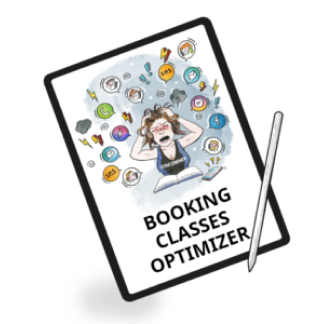Related Articles
Thinking about launching your own personal training business? Wondering if it’s worth it? Having no idea how to do it effectively?
We’ll explore why starting a personal training business matters and who can benefit. Whether you’re a seasoned trainer or a fitness industry enthusiast looking to turn passion into profit, we’ve got you covered. Let’s check how personal training entrepreneurship can be your next big step.
Nice to know:
1. The personal training industry is experiencing significant growth, with a projected annual growth rate of 2.9% from 2019 to 2024. (Source: IBISWorld) Sounds like a nice idea for your own business?
2. You can make your work easier by implementing a personal training software. Read more about it further in our article.
Types of personal training businesses
- Particular kind of sport specialist: You can conduct any kind of personal training you are a specialist at. Vaulting, weight lifting, pole dancing, no limits here! What’s more, there are great options of gym management software for many different specializations – crossfit gym software, boxing software, dance school software and many others.
- Sports and nutrition: You can specialize in the relationship between food, nutrition, diet and maximizing the effects of exercise.
- Strength and conditioning: Personal trainers often help to achieve specific fitness goals — complete the big race, get stronger or win the big game. This work consists of setting specific fitness goals to the clients and measuring success weekly or monthly.
- Posture and functional corrective techniques: You can help your clients correct posture-related issues, affecting their mobility, flexibility and overuse. The people you work with could be athletes who want to improve their form or a non-sporty person, willing to alleviate a desk job pain.
- Rehab and injury prevention: Many clients are recovering from major surgeries and injuries and are eager to understand how to move again.
- Weight loss: Like exercise & nutrition specialists, many personal trainers help clients create a holistic diet and weight loss plan.
- Psychological support in sports: The work of a sports psychologist is a separate professional area. But you surely have customers with their particular needs and goals. You can educate yourself and offer motivational support as a valuable additional element of your own business.

How to make money as a personal trainer
Making money as a personal trainer involves a few key steps. First, you need to build up your fitness business by offering quality training sessions and attracting clients. This might mean promoting yourself online or in your local community.
Once you have clients, you can earn money by charging them for your services.
Be sure about your pricing and prepared for this common question: “How much does a personal trainer cost and why so much?”. Be prepared to answer and justify the price calmly: personal training means offering personalized attention, individual plans and care of an educated fitness professional.
Some personal trainers also offer additional services like meal planning or online coaching, which can bring in extra income.
Check How much do gym owners make in 2024.
It’s also important to keep learning and improving your skills to stay competitive in the field. With dedication and hard work, you can turn your passion for fitness into a successful career as a personal trainer.
Nice to know:
In the United States alone, the fitness industry generates over $30 billion in revenue annually, indicating a substantial market for personal training services. (Source: Statista)
Pros and cons of opening a personal training business
As a personal trainer, you can easily get frustrated unless you establish a clear plan and set realistic expectations. Both to you and your clients.
Getting to potential clients is also quite a challenge. Especially at the beginning when you don’t have a recognizable brand. Not many existing clients are strong enough to recommend your service to new ones.
However, once you establish a successful business and build a solid reputation, word-of-mouth referrals can become a powerful tool in attracting new clients. Read more about the best fitness marketing strategies you can implement to promote yourself.
Having your own clients means you have the flexibility to set your own schedule and pricing. It can be a significant advantage in the personal training industry.

A Successful Personal Trainer Business – Tips
Here are some simple tips for opening a personal training business:
- Make sure your training really works and helps people reach their goals.
- Promise less, but give more than expected.
- Organize loud marketing actions at the beginning of your adventure. Let the people know you are there.
- Happy clients will tell their friends about you, so treat every client well.
- If you want to know more about earning and gaining clients for personal training business, read our another article: How to Get Personal Training Clients
- Always have written agreements to avoid misunderstandings.
- Be friendly to everyone you meet, not just those you want to sell to. People prefer to buy from people they like.
- Build connections with people who already have clients. For example, hairdressers can become great sources of referrals for your business

- Understand Your Clients. Both your future and existing clients have one thing in common. They want their fitness to be easier. Once you understand what the needs are, you can meet them.
- Being engaged and full of attention is not enough nowadays. Make it easier for your prospective clients to contact you, book and pay (introduce gym payment systems). Remind the existing ones about the training or making up the meeting thanks to class booking software.
Starting a Personal Training Business
- What you want vs what you can: Be realistic about your skills and possibilities. Start with who you are and develop yourself.
- Perform a market research: to understand your potential clients and competition better.
- Find your niche: in the fitness industry where you can excel.
- Create a business plan: outlining your goals and strategies.
- Look for a suitable location: that fits your target market and budget.
- Gather fitness equipment: based on and aimed at your services and clientele.
- Make sure you’re legally compliant: by obtaining necessary licenses and permits.
- Insure yourself: and your business to protect against unforeseen circumstances.
- Invest in interior design: to create an inviting atmosphere for clients.
- Sign contracts with staff: if you plan to hire help.
- Invest in marketing: to promote your services effectively.
- Prepare a spectacular opening: to attract attention and create buzz.
- Prepare ‘first week promotions’: to entice new clients.
- Recognize the importance of continuous learning: to stay updated and improve your skills.
- Automate your business with gym management software: to streamline operations.
- Think about future expenses and growth: to ensure sustainability and success in the long run.
Step 1. What You Want vs What You Can
Take a realistic approach. It means look at what you, as a trainer, already bring to the table versus what you dream of achieving. It will come with a bit more experience and can also cause a bump in earnings.
Currently you might offer personalized sessions, some niche expertise, or a cool coaching style that sets you apart. But down the road, you might be thinking about opening up more locations, hiring a team, and raking in more cash.
Still, it’s important to focus on what you can deliver right now. That’s what lays the groundwork for all the big dreams in the future.
Step 2. Perform a Market Research
The fitness industry is diverse. It consists of traditional gyms but also specialized studios and online coaching platforms.
Identify trends and demands in your local area. There could be, for example, a growing interest in specific workouts or wellness services.
Analyze your competitors to make your offerings different and unique. Appeal to your target audience.
Additionally, consider demographic factors. Age, gender, income levels, and lifestyle preferences are data which let you tailor your services effectively.
Step 3. Find Your Niche
Find your perfect place within the personal training industry. You can do it by identifying your unique strengths and areas of expertise. They are: weight loss, strength training, or specialized populations like seniors or athletes.
Tailor your services to meet the needs and goals of your target clientele. They may require one-on-one sessions, group training, or online coaching.
Showing yourself as an expert in your chosen niche will make you stand out in a crowded market. It attracts clients who are seeking specialized support and guidance.
Nice to know:
Consumers are increasingly seeking holistic wellness solutions, leading personal trainers to integrate services such as nutrition coaching, mindfulness training, and stress management into their offerings. (Source: IDEA Health & Fitness Association)
Step 4. Create a business plan
Make a list of all the important facts and data around your future entrepreneurship. A personal trainer gym business plan includes:
- what your offer is (sports, nutrition, mental support, others or a mix of them?)
- what you want to achieve,
- who your clients will be,
- how you’ll reach them.
In your personal training business plan you also need to think about:
- how much you’ll charge (one hour charge, a membership fee or other ideas?)
- how much you’ll spend,
- how you’ll make money.
This plan will help you stay on track and make your personal training business a success.

Step 5. Look for a suitable location
Location plays an important role in your fitness business. Gym owners in California, with its health-conscious culture, have a high average income. The same happens in vibrant and fast-paced New York. Wherever the work is sedentary, physical exercise afterward is a godsend.
So far we have made rather obvious observations. Let’s look at it from a different angle. Small towns or the countryside and a fitness place?
Seems unattractive at first glance. But what if you own a gym located far from the city, which is the only one in the area? Every potential customer will beat a path to your door!
Step 6. Gather fitness equipment
Before starting your business, gather fitness equipment and machinery. Their kind should obviously go together with your specialization and client needs. Depending on the services you plan to offer, ensure the essentials like:
- dumbbells,
- mats,
- cardio machines
and additional, special gadgets.
Having the right equipment you will be ready to provide quality workouts and attract clients from the get-go.
Don’t just buy these things at the beginning, but also take care of them during use. Require from the participants to do the same.

Step 7. Make sure you’re legally compliant
Make sure you’re legally compliant by getting a business license. Register your personal training business with your state authority. Choose a business structure like a sole proprietorship, partnership, LLC, or corporation.
Consider consulting with a legal professional specializing in small businesses. You’ll be more peaceful when your setup protects your personal assets and meets all legal requirements.
Important:
Accredited certifications such as NASM (National Academy of Sports Medicine) and ACE (American Council on Exercise) establish credibility and attract clients in the competitive personal training market.
Step 8. Insure yourself
Protect your personal training business. Consider getting liability insurance. It can cover you in case a client gets injured during a training session or if there’s property damage.
Additionally, explore options for health insurance to safeguard your own well-being. Having insurance can provide peace of mind and financial security in unforeseen situations.
Important:
Personal trainers must navigate legal and insurance considerations, including liability insurance and waivers, to protect themselves and their clients from potential risks and accidents during training sessions. (Source: American Fitness Professionals & Associates)
Step 9. Invest in interior design
Create an inviting and professional atmosphere for your personal training business. Choose colors, lighting, and furnishings that reflect your brand. The interior should also make clients feel comfortable and motivated.
A well-designed space can enhance the overall client experience and set you apart from competitors. Consider consulting with a professional interior designer to help bring your vision to life. What’s important – within your budget.

Step 10. Sign contracts with staff
Do you see yourself as an independent personal trainer? Or do you want to hire some fitness professionals? They say headcount is for show; revenue’s for dough. The number of employees is not a determinant of the gym’s profitability.
Yet, we would like to draw your attention to the value of those people who have direct contact with the customer. Personal trainers on the gym floor create the atmosphere of the club. They attract new customers thanks to the recommendations of satisfied ones.
Of course, self employed personal trainers will also be valuable on the market. Choose your way.

Step 11. Invest in marketing materials
Yes, marketing materials are important. Yet, it pays off only when you invest wisely and prioritize the materials according to your target audience.
The visual identification must be a reflection of your style. But should also match with the client’s imagination and expectations.
What do you think about working with a professional designer or marketing agency? It would ensure that your materials effectively communicate your training business. You also need to resonate with your target market.
Step 12. Prepare a spectacular opening
Host a ‘Grand Opening Event’! Plan an opening event to introduce your business to the community. This could include a ribbon-cutting ceremony, free demonstrations, giveaways, and refreshments.
It’s a fantastic opportunity to showcase your services and engage with potential clients.
Before the big day, build buzz on social media. Share interesting photos of your facility, introduce your team, and tease upcoming promotions. Encourage followers to spread the word by sharing your posts and tagging a friend (potential client!) who might be interested.

Step 13. Prepare ‘first week promotions’
Here are some hints for preparing “first-week promotions” for your new personal training business:
- Free trial meeting: Offer trial sessions to prospective clients during your first week. This allows them to experience your training style and decide to continue their fitness adventure with you.
- First week discount: This wakes up early commitment and helps attract new clients.
- Social media giveaways: Organize social media giveaways during your first week. It will generate excitement and awareness about your business.
- Open house event: Make it possible for people to drop by, meet you, tour your facility, and learn about your services. Offer small events, refreshments, presentations, conversations. that;s how you’ll make the event memorable and encourage sign-ups.
- Limited-time offer: create a sense of urgency by promoting limited-time offers or flash sales. Exclusively available during your first week! This encourages potential clients to take action quickly and not miss out on the opportunity.
- Local advertising: Advertise your first week promotions through local channels. They can be community newsletters, bulletin boards, or local newspapers. It’s important to reach potential clients in your area.

You will surely have more ideas. Be fresh! Don’t hesitate to implement them!
Remember to communicate the details of your promotions. Keep all the terms and conditions clear. Be sure that you provide excellent service to create a positive first impression with new clients.
Good luck with your first-week promotions!
Step 14. Importance of Continuous Learning
Develop yourself and improve as a personal trainer. Don’t omit additional certifications and training programs to expand your knowledge and skill set. You can become a certified personal trainer through recognized organizations.
Specialize your service by focusing on specific areas of fitness, such as strength training, yoga, or nutrition. It will help you to better meet the needs of your clients and stand out in the industry.
Investing in your ongoing education and professional development can enhance your credibility. That’s how you attract more clients and lead to success in your personal training career.
Nice to know:
There’s a growing demand for specialized training services such as pre/postnatal fitness, senior fitness, and corrective exercise programs due to an aging population and increased awareness of specific health needs. (Source: American Council on Exercise)
Step 15. Automate business with gym management software
A club management system can save you time and money. Choose a software that offers you several useful options in one product. These functions may be: online booking, absence management, payment processing, and many others.
Check more details of a recommended software features: what features and benefits you get with WodGuru gym management software:
- Email and SMS automation: There’s no need to remember sending all those messages to your club members.
- Online workout schedule: Easy and accessible, with no mistakes during implementing changes.
- Gym reports: Get info about everything that happens in your place. No matter if it’s your group or one of your trainer’s.
- Online payments: Make it as easy as possible for your clients to pay.
- Website integration: help potential clients register at your club within a few seconds. Also, website integration helps avoid typos in new clients’ data.
- Attendance list: Check if some of the classes are omitted too often. Let the members know if classes get canceled, rescheduled, or have a new instructor.
- Reception: Save your staff’s time. Automate the reception tasks. Selling products and memberships, issuing invoices, integrating with gym card readers was never so easy!
- Custom branded fitness app: Make it always achievable to book, check or pay. Remind you members about your existence every time they look at their phone. It happens often, doesn’t it?
- Discount codes: not necessary to prove why it’s nice, right?
Nice to know:
Subscription-based personal training models, where clients pay a monthly fee for access to a set number of sessions, are gaining popularity, offering clients flexibility and trainers a steady income stream. (Source: Club Industry)
WodGuru
Favorable price: 1 $ per member, max 249 $
Useful features
Incredible user support – check the clients’ opinions: WodGuru clients’ opinions
If you want to try WodGuru system for free, here it is: WodGuru trial version
Step 16. Think about expenses and growth
Thinking ahead to the future, let’s focus on growing and investing in our business. There are so many options for personal trainers out there!
Try things like online coaching, making custom training plans, or selling supplementary fitness products!
Now you are starting your own personal training business. But maybe soon you’ll be ready to bring on more people or open another spot of your personal training studio? Let’s keep it open-minded and see where it takes us!
Future Growth Options – Online Coaching
It is a perfect idea for personal trainers to broaden their offer and earning opportunities.
Online fitness coaching is a mix of delivering:
- personalized training,
- nutrition hints,
- wellness guidance,
- customized workout plans,
- virtual training sessions,
- ongoing support.
It is performed remotely through digital platforms:
- video calls,
- messaging apps,
- fitness apps.
It is a synonym of convenience, flexibility, and accessibility. Online fitness coaching is gaining popularity because it’s scalable and affordable. The trainers will be able to reach clients globally. It has become a significant trend in the fitness industry.
Nice to know:
The COVID-19 pandemic accelerated the adoption of online personal training services, with a reported 87% increase in online fitness class attendance during the pandemic. (Source: Mindbody)





